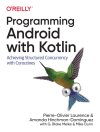Programming Android with Kotlin
Авторы: Pierre-Olivier Laurence, Amanda Hinchman-Dominguez, G. Blake Meike, Mike Dunn (2021)

JetBrains created Kotlin for two reasons: there was no language that filled all the gaps in Android development using (legacy) Java libraries, and a new language would allow Android development to set trends, rather than just follow them.
In February 2015, Kotlin 1.0 was officially announced. Kotlin is concise, safe, pragmatic, and focused on interoperability with Java code. It can be used everywhere Java is used today: for server-side development, Android apps, desktop or portable clients, IoT device programming, and much, much more. Kotlin gained popularity among Android developers quite rapidly, and Google’s decision to adopt Kotlin as the official language of Android development resulted in skyrocketing interest in the language. According to the Для просмотра ссылки Войдиили Зарегистрируйся, more than 60% of professional Android developers currently use Kotlin.
The learning curve in Android is rather steep: admittedly, it’s hard to learn and harder to master. Part of the Android developer “upbringing,” for many, is to be exposed over time to unintended interactions between the Android operating system and the application. This book intends to bring those kinds of exposures to readers in depth and up close by examining such problems in Android. We’ll talk not only about Kotlin and Java, but also about the concurrency problems that arise when using Android and how Kotlin is able to solve them.
We will sometimes compare Kotlin to Java when we believe doing so provides better insight (especially since most readers are expected to have a Java background). We can demonstrate, with working examples, how to bridge that gap, and how the underlying concepts of most Kotlin operations are more similar to the Java equivalent than not. The tasks will be organized by topic to provide software engineers with a structured decomposition of that mass of information, and they will show how to make an application robust and maintainable.
Additionally, users familiar with Java—including Android developers—will find their learning curve dramatically flatten when we present each of the common tasks in both Java and Kotlin. Where appropriate, we’ll discuss the difference and the pitfalls of one or both, but we hope to provide bite-size and easily digestible examples of a task that will “just work,” and enable the reader to consume and adapt to the modern paradigm, as well as become aware of the significance of the updated code immediately and instinctively.
While Kotlin is fully interoperable with Java, other Java application development (server-side programming, desktop clients, middleware, etc.) has not caught on to the extent that Android has. This is largely due to the maintainer of Android (Google) strongly “encouraging” its users to make the change. Users are regularly migrating to Kotlin, but even more still fall back to Java for mission-critical work. Our hope is that this book will serve as the lifeline an Android developer needs to feel safe in committing to the advantages and simplicity that Kotlin represents.
Авторы: Pierre-Olivier Laurence, Amanda Hinchman-Dominguez, G. Blake Meike, Mike Dunn (2021)

JetBrains created Kotlin for two reasons: there was no language that filled all the gaps in Android development using (legacy) Java libraries, and a new language would allow Android development to set trends, rather than just follow them.
In February 2015, Kotlin 1.0 was officially announced. Kotlin is concise, safe, pragmatic, and focused on interoperability with Java code. It can be used everywhere Java is used today: for server-side development, Android apps, desktop or portable clients, IoT device programming, and much, much more. Kotlin gained popularity among Android developers quite rapidly, and Google’s decision to adopt Kotlin as the official language of Android development resulted in skyrocketing interest in the language. According to the Для просмотра ссылки Войди
The learning curve in Android is rather steep: admittedly, it’s hard to learn and harder to master. Part of the Android developer “upbringing,” for many, is to be exposed over time to unintended interactions between the Android operating system and the application. This book intends to bring those kinds of exposures to readers in depth and up close by examining such problems in Android. We’ll talk not only about Kotlin and Java, but also about the concurrency problems that arise when using Android and how Kotlin is able to solve them.
We will sometimes compare Kotlin to Java when we believe doing so provides better insight (especially since most readers are expected to have a Java background). We can demonstrate, with working examples, how to bridge that gap, and how the underlying concepts of most Kotlin operations are more similar to the Java equivalent than not. The tasks will be organized by topic to provide software engineers with a structured decomposition of that mass of information, and they will show how to make an application robust and maintainable.
Additionally, users familiar with Java—including Android developers—will find their learning curve dramatically flatten when we present each of the common tasks in both Java and Kotlin. Where appropriate, we’ll discuss the difference and the pitfalls of one or both, but we hope to provide bite-size and easily digestible examples of a task that will “just work,” and enable the reader to consume and adapt to the modern paradigm, as well as become aware of the significance of the updated code immediately and instinctively.
While Kotlin is fully interoperable with Java, other Java application development (server-side programming, desktop clients, middleware, etc.) has not caught on to the extent that Android has. This is largely due to the maintainer of Android (Google) strongly “encouraging” its users to make the change. Users are regularly migrating to Kotlin, but even more still fall back to Java for mission-critical work. Our hope is that this book will serve as the lifeline an Android developer needs to feel safe in committing to the advantages and simplicity that Kotlin represents.
